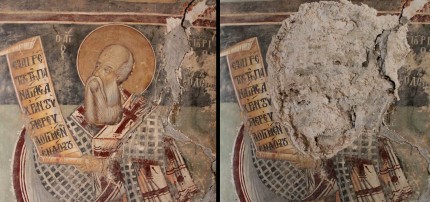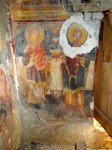 Frescoes in the 16th-century Orthodox church of St. Friday’s in Valsh, a remote Albanian village 35 miles south of Tirana, have been damaged beyond repair by looters. Twice in a week, the first time on December 30th, the second on January 4th, thieves hacked at the frescoes with axes and knives, focusing mainly on removing the heads of saints.
Frescoes in the 16th-century Orthodox church of St. Friday’s in Valsh, a remote Albanian village 35 miles south of Tirana, have been damaged beyond repair by looters. Twice in a week, the first time on December 30th, the second on January 4th, thieves hacked at the frescoes with axes and knives, focusing mainly on removing the heads of saints.
To add insult to injury, the looters were incompetent. Most of the seven or eight frescoes (the number is different in different reports) attacked wound up crushed in pieces on the floor instead of removed whole. Some of the worst damage was done to the fresco of St. Friday’s. His entire head and the aureole around it is gone, as is the inscription to the left of the halo which was important for art historical reference.

The frescoes are by master icon painter Onufri who lived in Valsh and frescoed the walls of its modest little church in 1554. Known for his use of brilliant colors and his introduction of more realistic facial expressions into the flat conventions of Byzantine style, Onufri is considered Albania’s greatest icon maker, although it’s not certain if he was born in what is today Albania or in northern Greece. The signature on his Valsh frescoes — Protopapas — indicates he held a position of importance in the Greek Orthodox church.
 The first bout of destruction was discovered by the villagers who notified the police, local heritage officials and the Orthodox Church immediately. The locks were changed but nothing else was done to protect the church, and the thieves just waltzed right back in five days later and hacked at the walls some more. The ease with which this offense was perpetrated has led some heritage advocates to suspect that the police may have been involved, or at least paid off.
The first bout of destruction was discovered by the villagers who notified the police, local heritage officials and the Orthodox Church immediately. The locks were changed but nothing else was done to protect the church, and the thieves just waltzed right back in five days later and hacked at the walls some more. The ease with which this offense was perpetrated has led some heritage advocates to suspect that the police may have been involved, or at least paid off.
Albania is a very bad space right now when it comes to heritage protection. Since the fall of the communist regime in 1991, more the 2,000 icons have been stolen from churches and museums. In the past two years alone, 20 Orthodox churches and monasteries have been targeted by looters. In 2007, the Ministry of Culture eliminated the custodian system which, while fairly weak, at least ensured that sites of cultural and historical importance were guarded by a living breathing human being. It was cheap, too. The guards were paid €30 ($40) a month, for a total yearly cost to the government of just €40,000 ($54,000).
I don’t care how broke they are, there is no way that this program had to be eliminated purely to save costs. In fact, after years of protests from Orthodox officials and heritage advocates, in 2011 the government budgeted €200,000 ($266,000) for cultural heritage protection. This did not assuage the people concerned about the decimation of Albania’s history, because it’s a ludicrously paltry sum.
The Ministry of Culture is irritatingly fatalistic about this ongoing disaster. Head of the heritage department Olsi Lafe said at a press conference last week that they are working with the police on the thefts at Valsh, but there isn’t much they can do on the larger problem. They have too much territory, much of it rural, to cover effectively.
“Considering the large number of religious heritage monuments, it’s impossible to protect them 24-hours a day,” the ministry said. “It would require a large number of people and a special administrative structure,” it added.
Yes it’s amazing how significant programs require manpower and funding. Shocking news there.